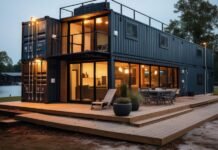In 2021, architects Rakhee Bedi and Shobhit Kumar found themselves faced with a unique and exhilarating challenge. Based in the bustling Delhi NCR region, they were commissioned to design a farmhouse—a request they frequently received. However, this particular project stood out for its distinctive eco-friendly vision.
Embracing Nature in Uncommon Ways
The clients, a couple who had recently relocated to their sprawling 3-acre farmland at the foothills of the Aravali Hills, were looking for something more than just a conventional residence. They envisioned a sustainable home constructed from refurbished shipping containers. Their journey to this point was spurred by a desire for a more harmonious living space that intertwined with nature rather than standing apart from it.
“When the pandemic hit, and the government locked down, I could not imagine living in an apartment. We decided to move to our farmland, where there was just one room,” shared the owners of ‘Champa and Chameli’, their charming twin homes named after the couple’s late dogs.
Crafting Chameli and Champa
The architects executed a remarkable transformation of two shipping containers measuring 40×8 feet each to create Chameli, while five 20×8 feet containers were ingeniously combined to form Champa. Rakhee and Shobhit’s goal was to create residences that felt warm and homely, despite their unconventional building materials.
“The project was unique for us. We had previously focused on industrial projects, but this was different. We aimed to harmonize the construction with the surrounding nature,” said Shobhit, encapsulating the purpose behind their innovative endeavor.
Living with the Wild
The couple, whose work involves import and export, provided the shipping containers required for the project. Their vision was crystal clear: they wanted a home immersed in greenery, where they wouldn’t disrupt the existing biodiversity of their land.
“Initially, we didn’t know if we wanted to live there full time. But the tranquility and the lush surroundings convinced us otherwise. We wanted a home that embraced nature, not a stark structure,” explained one of the owners.
Shobhit elaborated further: “The clients were firm about their desire for a farmhouse that didn’t resemble typical Delhi designs. They appreciated the opportunity to wander and reconnect with nature.”
A Home that Blends In
The architects took care to ensure that their designs preserved the integrity of the land. “We incorporated the existing trees and ensured that the construction wouldn’t necessitate the cutting down of any of them. Upon entering the property, the houses reveal themselves only gradually, creating a hidden oasis among the towering trees,” said Shobhit.
This intentional planning highlights the house’s unassuming appearance, which offers both privacy and a connection to the environment.
Balancing Space and Sustainability
Building homes from shipping containers brings a set of distinct challenges, especially when situated in vibrant natural surroundings. One of the main hurdles was the location’s topographical contours. “Considering we were at the foothills of the Aravalis, we had to navigate various governmental restrictions on heavy construction. Obtaining permissions was essential,” Shobhit recounted.
The couple sought a compact living unit rather than a sprawling estate. Recognizing this, the architects designed a cozy gym out of a 20×8 container, complemented by an outdoor yoga area.
A highlight of the architecture involved creating ample sun exposure and breathtaking views by utilizing the natural slopes of the land. “By situating the containers slightly higher up on the fibers of the land, we maximized natural light without imposing upon the surroundings,” noted Shobhit.
A Harmonious Design
As Shobhit described, the design philosophy emphasized simplicity and functionality: “Chameli is sleek, with an open layout that lacks walls separating the kitchen, living, and bedroom areas—all apart from the bathroom.” Alternatively, Champa donned a more traditional design, accommodating privacy and a unique structure that suited the mother’s preferences.
The sustainable materials used for the project set it apart even further—from the shipping containers themselves to recycled wood for decks and floors. The architects even incorporated bamboo poles topped with thatching to shield the decks from harsh sunlight.
In Perfect Harmony with Nature
“The client’s values regarding nature aligned perfectly with ours,” shared Shobhit, who believes that while awareness of sustainable living is increasing, there is still much progress to be made.
The culmination of this journey saw the two homes completed in just eight months, with Champa costing approximately Rs 35 lakh and Chameli Rs 40 lakh.
A New Way of Life
Life in a shipping container home surrounded by nature has profoundly shifted the owners’ perspectives. “I have lost a lot of closet space, but I have gained a lot of nature. Isn’t that a wonderful tradeoff? We literally sleep under the sky among the trees; it’s amazing. The only challenge is learning to let go of material possessions, but every moment spent here makes it worthwhile,” one resident reflected.
In a world increasingly recognizing the need for sustainability, the story of ‘Champa and Chameli’ stands as a shining example of what it means to live harmoniously with nature—encapsulating resilience, creativity, and the beauty of the surrounding environment.
Conclusion
The tale of Rakhee Bedi and Shobhit Kumar’s architectural adventure redefines the essence of modern living. It showcases the endless possibilities that arise when we prioritize sustainability, creativity, and a profound respect for nature. Through their work, they inspire us to rethink our homes and the spaces we inhabit, urging us toward a future where architecture and nature exist in beautiful equilibrium.














